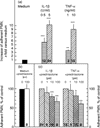Prednisolone inhibits cytokine-induced adhesive and cytotoxic interactions between endothelial cells and neutrophils in vitro
- PMID: 10691915
- PMCID: PMC1905574
- DOI: 10.1046/j.1365-2249.2000.01165.x
Prednisolone inhibits cytokine-induced adhesive and cytotoxic interactions between endothelial cells and neutrophils in vitro
Abstract
We assessed whether prednisolone influenced the ability of human polymorphonuclear neutrophils (PMN) to adhere to and cause lysis of human umbilical vein endothelial cells (HUVEC) in vitro (as measured by the release of 51Cr). Pretreatment of the endothelium with IL-1beta or tumour necrosis factor-alpha (TNF-alpha) caused prominent endothelial E-selectin expression and endothelial hyperadhesiveness for neutrophils, as well as PMN-mediated cytotoxicity. All these processes were dose-dependently reduced when prednisolone was added to the assay system. This protective effect remained when HUVEC alone were pretreated with the drug prior to washing and cytokine activation. Likewise, when HUVEC cytotoxicity was induced by the nitric oxide (NO) donor S-nitroso-acetyl-penicillamine (SNAP), prednisolone reduced cell injury significantly. In contrast, prednisolone did not interfere with signalling systems between TNF-alpha-stimulated HUVEC and quiescent PMN such as IL-8 generation and release of cytosolic Ca2 + in the PMN. Thus, in this in vitro model of vasculitis, prednisolone dose-dependently reduced cytokine-induced E-selectin expression and HUVEC hyperadhesiveness for neutrophils, as well as reducing neutrophil-dependent cytotoxicity against HUVEC via NO-dependent steps.
Figures




References
-
- Ward PA, Varani J. Mechanisms of neutrophil-mediated killing of endothelial cells. J Leuk Biol. 1990;48:97–102. - PubMed
-
- Weiss SJ. Tissue destruction by neutrophils. N Engl J Med. 1989;320:365–76. - PubMed
-
- Stroncek DF, Vercellotti GM, Huh PW, Jacob HS. Neutrophil oxidants inactivate alpha-1-protease inhibitor and promote PMN-mediated detachment of cultured endothelium. Protection of free methionine. Arteriosclerosis. 1986;6:332–40. - PubMed
-
- Fauci AS, Leavitt RY. Vasculitis. In: McCarty DJ, Koopman WJ, editors. Arthritis and allied conditions. 12. Philadelphia: Lea & Febiger; 1993. pp. 1301–19.
Publication types
MeSH terms
Substances
LinkOut - more resources
Full Text Sources
Miscellaneous

